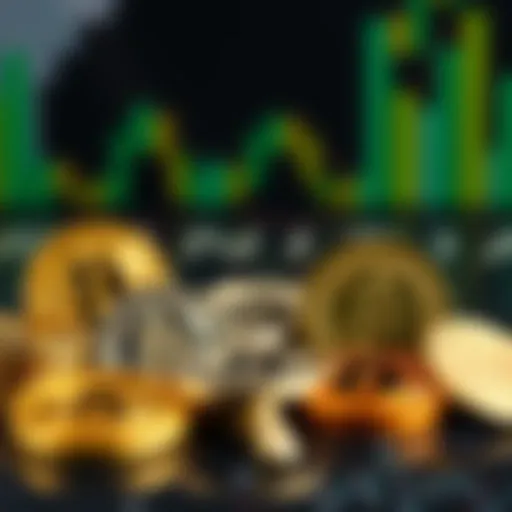Gold Backwardation: Its Impact on Precious Metals Trading


Intro
The value of gold is a subject as timeless as the metal itself. Each fluctuation, each peak, and each dip tells a story. At the heart of these narratives is a rather intriguing phenomenon called gold backwardation. This term describes a situation where the spot price of gold—a detailed reflection of the current market conditions—overtakes the futures price. But why should investors, traders, and market analysts lift an eyebrow at this? The answer lies in the deep implications of backwardation for understanding market trends and investor sentiment.
"In financial markets, understanding the signal behind the noise can often lead to monumental advantages."
Gold backwardation isn't merely a statistic. It speaks volumes about supply and demand dynamics, investor behavior, and broader economic sentiments. This is particularly relevant as the worlds of precious metals and cryptocurrency intermingle. As we navigate through this article, we will unravel how backwardation can serve as a barometer for not only the gold market, but also give hints about the direction of cryptocurrency movements.
To embark on our journey, we'll first peel back the layers on market analysis. From current trends in cryptocurrency to nuanced price prediction techniques, we'll dig into the elements that shape investor decision-making.
The subsequent sections will pivot to investment strategies, examining the long-term versus short-term investing, and delving into the sophisticated world of risk management within crypto trading. This exploration will equip you with insights to better navigate your investment endeavors in an increasingly complex marketplace.
Prelude to Gold Backwardation
Understanding gold backwardation is critical for investors and traders in the precious metals market. This phenomenon, where the spot price of gold exceeds its futures price, signals a shift in market dynamics and sentiment. The implications of backwardation can lead to actionable insights for prudent market participation.
Gold backwardation is not just a financial concept; it serves as a barometer for market health and investor confidence. Recognizing its significance helps investors navigate through complex trading environments and adjust strategies accordingly.
Definition of Gold Backwardation
Gold backwardation essentially occurs when the current price of gold (spot price) is higher than the price for gold to be delivered in the future (futures price). This situation rarely arises in stable market conditions and indicates heightened demand for immediate gold possession as opposed to future delivery. It's like preferring a hot meal over a promise of a meal next week; the immediate utility outweighs future expectations.
For instance, if the spot price is $1,500 per ounce while futures for a three-month delivery is priced at $1,490, it exemplifies backwardation. Investors and traders see this as a sign that gold is currently valued more in the here-and-now rather than later.
Comparison with Gold Contango
In contrast, gold contango is the opposite scenario. Here, the futures price of gold is above the current spot price. This situation often reflects a more stable market or expectations of lower demand in the future. Both backwardation and contango play significant roles in shaping investor strategies but serve different conditions.
Consider the following points of difference:
- Market Sentiment: Backwardation suggests bullish sentiment; investors are eager to hold gold now. In contrast, contango often indicates that investors are more confident in future availability and stability.
- Investment Strategies: During backwardation, investors might look to secure physical gold immediately. Conversely, in contango, it may be more advantageous to enter into futures contracts.
- Risk Factors: Backwardation may indicate imminent market stress, while contango may suggest complacency in market conditions.
Understanding these dynamics is essential for trading decisions, especially in fluctuating economic landscapes.
Mechanisms of Backwardation in Gold
Gold backwardation is an unusual state in the bullion market, one that can paint a vivid picture of market dynamics. Understanding its mechanisms is crucial, especially for traders and investors who are keen on deciphering the forces at play in precious metals.
Supply and Demand Factors
The principle of supply and demand forms the backbone of backwardation mechanics. When the demand for physical gold spikes, usually due to economic uncertainty, it can outweigh the available supply. For instance, think about a scenario where geopolitical tensions rise or during instances of financial instability. Traders and investors want immediate access to gold rather than waiting for future delivery, thereby pushing spot prices higher. This phenomena can also occur in markets where production has stalled due to unforeseen circumstances, such as natural disasters or mining strikes.
As buyers scramble to secure gold for immediate delivery, the futures price tends to dip because sellers are uncertain about future conditions. In essence, the urgent need for physical gold signals to the market that current economic conditions are less favorable than what might be expected in the future. It's this imbalance between current demand and future expectations that drives backwardation, making it a significant indicator for investors.
Market Sentiment and Speculation
Market sentiment often operates like a driving force, influencing perceptions and decisions in the gold market. During times of crisis, fear can easily overtake rational thinking, leading traders to anticipate future devaluation of currencies. This heightened sense of precariousness tends to drive demand for tangible assets such as gold, which can explain the surge in spot prices under certain conditions.


Speculation also plays a dual role here. Some investors might see backwardation as a signal that gold is undervalued, prompting them to buy now to eliminate the risk of paying a premium later. Conversely, pessimism about economic recovery can dissuade others, perpetuating backwardation as more participants lean towards immediate acquisition. The interplay of these emotions and expectations makes market sentiment a critical factor in understanding how backwardation manifests.
"In markets dominated by emotions rather than fundamentals, prices can move in ways that defy traditional economic logic."
Hedging and Its Role
Hedging serves as another cog in the machinery of backwardation. When investors or entities perceive increasing risk in the market, they may opt to hedge their positions by purchasing gold. This act not only allows them to mitigate losses but also influences market dynamics.
In a backwardation scenario, hedging can lead to an increase in demand for physical gold, as investors seek to protect their portfolios from adverse price movements. This hedging activity reinforces the urgency associated with acquiring immediate gold, further exacerbating the gap between spot and futures prices. Hedgers, in effect, contribute to a cycle where the fear of loss translates into immediate purchasing power, thus pushing spot prices higher still. Ultimately, understanding hedging strategies can offer valuable insights into market trends and risk management in times of backwardation.
Historical Context of Gold Backwardation
Understanding the impact and significance of gold backwardation requires a deep dive into its historical context. This backdrop not only illuminates the dynamics of the precious metals market but also provides insights into investor behavior, market reactions during crises, and broader economic indicators associated with gold. By examining notable instances and events, one can grasp how backwardation has manifested and what it signifies.
Notable Instances in History
Gold backwardation has not been a regular occurrence; rather, it tends to emerge in specific conditions that highlight market anxiety and supply chain dynamics. Key instances in history illustrate how pivotal moments in economic contexts can lead to backwardation:
- 1970s Energy Crisis: During the oil crisis, inflation soared while investor confidence waned, pushing investors towards tangible assets like gold, resulting in backwardation as spot prices eclipsed futures.
- 2008 Financial Crisis: The breakdown of the financial system led to a flight to safety. Investors rushed to hold physical gold, creating a situation where immediate demand outstripped future expectations, thus resulting in backwardation.
- COVID-19 Pandemic: The market turbulence triggered by the pandemic brought forth not just physical shortages due to supply chain disruptions, but also a heightened demand for securing assets. This phenomenon again resulted in backwardation, with spot prices surging.
Each of these examples reflects how external economic shocks and shifts in investor sentiment can create conditions ripe for backwardation.
Impact of Economic Crises
Economic crises often reshape the landscape of various asset classes, with gold standing out as a safe haven during times of turmoil. Backwardation often signals not only fear and uncertainty but also a mismatch between immediate demand and future supply. This can be traced back to several key aspects:
- Investor Behavior: In times of economic distress, such as recessions, investors typically flock to precious metals to hedge against economic instability. The rush for immediate liquidity often leads to a scarce supply of gold on the market.
- Market Psychology: The widespread panic and uncertainty can skew investor perceptions, leading them to favor physical gold over futures contracts, typically perceived as less tangible.
- Monetary Policy Response: Central banks’ actions during crises often exacerbate the situation. Decisions such as lowering interest rates can lower the opportunity cost of holding physical gold, thus increasing its attraction relative to non-physical assets.
Gold Backwardation during Financial Uncertainty
Throughout history, periods of financial uncertainty have consistently inspired backwardation in gold markets. Understanding its significance requires acknowledging the sentiments precluding these phenomena. Factors directly influencing backwardation include:
- Liquidity Crises: As financial institutions grapple with liquidity shortages, they may prioritize immediate cash flows, inadvertently boosting gold's spot price.
- Geopolitical Tensions: Events such as wars and political instability stimulate demand for gold, leading to backwardation as investors value current security over uncertain future conditions.
- Macroeconomic Indicators: When economic data begins to show signs of distress—such as declining GDP growth or rising unemployment—investor behavior shifts accordingly, often resulting in backwardation as demand quickly exceeds supply.
The occurrence of gold backwardation serves as a barometer for the health of financial markets, providing insights into the collective investor psyche and economic indicators.
Relevant resources for further exploration include Britannica, Wikipedia, and discussions on platforms like Reddit that delve into both historical and current events affecting gold markets.
Significance of Gold Backwardation for Investors
Understanding gold backwardation is pivotal for investors who seek to navigate the complex landscape of the precious metals market. When the spot price of gold surpasses the futures price, it signals underlying market dynamics that can influence various trading decisions and long-term strategies. This phenomenon is not just an abstract concept; it embodies real implications for investment choices, market timing, and even portfolio diversity.
Investment Strategies in Backwardation Markets
Investors can capitalize on gold backwardation by employing several tactical approaches. For starters, purchasing physical gold during backwardation could provide a hedge against inflation and currency fluctuations. When market indicators suggest backwardation, it often reveals strong demand for immediate ownership of gold, suggesting potential increases in its future value.
It's also helpful to engage in options trading. By buying call options in a backwardation environment, one might capitalize on the rising prices of gold without the need for full upfront investment. Futures trading can also play a role; conversely selling futures contracts at elevated prices while holding physical gold can allow investors to profit should the prices stabilize at those higher levels.


One usual strategy is to keep an eye on the trends of gold backwardation, complemented by news flow related to market and economic conditions. For instance, if geopolitical issues arise or inflation trends upward, these could further exacerbate backwardation.
Risk Analysis and Management
Engaging with backwardation requires a thoughtful approach to risk analysis. It is crucial to remember that while backwardation often points to bullish sentiments in the market, it doesn't guarantee that prices will continue to rise. A diligent investor should balance this sentiment with a keen eye on potential triggers that may reverse market conditions.
Consideration of liquidity is vital, as trends can shift rapidly. Instruments like stop-loss orders can help manage risk exposure effectively. Additionally, market sentiment can play a crooked role: while backwardation implies scarcity and elevated immediate demand, unexpected economic shifts can lead to quick price corrections. Hence, a systematic analysis of both market trends and underlying economic indicators should form the bedrock of an investor's strategy in times of backwardation.
Diversification Benefits
Gold backwardation also opens avenues for diversification in investment portfolios. Historically viewed as a safe haven, gold can act as a counterbalance to riskier asset classes, especially in turbulent market conditions. Including gold in a backwardation scenario can bolster an investor's portfolio against volatilities in traditional markets, such as stocks and bonds.
Incorporating gold into a diversified strategy is not merely a financial tactic; it represents an acknowledgment of gold's intrinsic value amidst fluctuating currencies and economic upheaval.
"Diversification is a key principle for investors seeking stability; gold can be a linchpin, especially in backwardation phases where sentiment favors its immediate value."
Economic Indicators Related to Gold Backwardation
Understanding the economic indicators that tie into gold backwardation is paramount for those looking to navigate the precious metals market. Gold backwardation occurs when the spot price of gold is higher than its futures price. This curious state often signals rising demand or economic uncertainty, making it essential for investors to grasp the factors contributing to this phenomenon.
Inflation and Currency Strength
When inflation rears its ugly head, the purchasing power of money decreases, which usually pushes investors towards tangible assets like gold. This often leads to an increase in demand and can help drive the market into backwardation. In moments of high inflation, the worth of currencies—be it the dollar, euro, or yen—can wane, making gold a safe harbor in uncertain seas.
Key points to consider:
- Inflation can cause a rush to gold as a hedge.
- If currency strength diminishes, expect upward pressures on gold prices.
"High inflation coupled with weakening currency often creates an environment ripe for gold backwardation, as investors prioritize stability."
This interplay of inflation and currency dynamics is crucial to understanding market behavior. When investors anticipate rising inflation, they may buy gold in greater volumes, thereby leading to an imbalance between supply and demand in the short term.
Interest Rates and Gold Backwardation
Interest rates play a classic tug-of-war with gold prices. Generally, higher interest rates tend to strengthen the dollar, causing gold—a non-yielding asset—to falter in attraction. However, in certain scenarios, a decision by central banks to lower interest rates can stimulate gold purchases. When there's a sense that interest rates will remain low for an extended period, or if there's a cut in rates during stormy economic times, the future prices of gold might not keep pace with current spot prices—resulting in backwardation.
Factors influencing this relationship include:
- Monetary policy changes by central banks.
- Market perceptions about future interest rate moves.
In a nutshell, it’s essential to keep your ear to the ground on interest rates. Decisions made by bodies like the Federal Reserve often ripple through the commodities market, impacting not just gold but the trading psyche of the broader investment community.
Geopolitical Factors
Finally, the world of politics undeniably impacts gold backwardation. Geopolitical tension—be it trade wars, military conflicts, or diplomatic standoffs—can significantly alter investor sentiment. During such turbulent times, gold often gets swamped with buying interest, resulting from fears over economic stability.
Consider these points:


- Global unrest often results in heightened demand for gold.
- Wars, sanctions, or political upheaval can prompt a rush to secure precious metals.
As the state of global affairs ebbs and flows, so too does the demand for gold, making it an essential indicator for traders and investors trying to predict shifts in the market. Every geopolitical event has a ripple effect, and savvy investors need to be on their toes.
Emerging Trends in Gold Backwardation
Understanding emerging trends in gold backwardation is crucial for investors who keep their finger on the pulse of the precious metals market. As global dynamics shift constantly, these trends can significantly impact trading strategies and investor behavior. It’s vital to stay alert about recent developments that might influence gold’s pricing landscape, especially as economic conditions change and technological advancements shake up traditional practices.
Technological Advancements in Trading
The trading landscape has experienced a revolutionary shift lately, primarily due to technological innovations. From algorithmic trading systems to blockchain applications, these advancements help investors analyze market conditions faster than ever before. For instance, platforms offering real-time data analytics can identify backwardation patterns quickly, allowing traders to make timely decisions.
Moreover, the utilization of machine learning in predicting price movements has garnered a lot of attention. It opens up new possibilities for recognizing potential backwardation, additionally offering adaptive strategies based on extensive historical data analysis. Integrating tools that leverage big data might become a necessity for investors who wish to stay ahead in a volatile market.
Shifts in Global Gold Supply Chains
The global gold supply chain is always in flux, influenced by geopolitical tensions, mining operations, and regulatory changes. Recently, there’s been a noticeable trend towards increased transparency in sourcing. Investors are becoming more aware of ethical sourcing practices, which can affect demand for gold. When supply chains become strained, perhaps due to trade disputes or environmental regulations, it may push prices up, contributing to backwardation.
Furthermore, as more countries ramp up their gold production and stockpiling efforts, the balance between supply and demand can shift dramatically. This could lead to increased instances of backwardation, prompting traders to reassess their positions frequently. Staying attuned to these developments helps investors to strategize effectively and manage their risk.
The Role of Cryptocurrencies in Precious Metals
As cryptocurrencies gain traction in investment circles, their relationship with traditional commodities like gold becomes more intriguing. Many investors are exploring cryptocurrencies as a hedge against inflation—similar to how gold functions traditionally. Whether valid or not, the perception that cryptocurrencies could mirror gold's safe-haven attributes can influence market sentiments.
When crypto markets see turbulence, some investors might flock back to traditional assets, creating scenarios that could result in backwardation. The dynamic interplay between these two asset classes prompts traders to consider the implications these emerging digital currencies hold for the precious metals market. Understanding how cryptocurrencies affect perceptions of value and risk is paramount for those involved in gold trading.
"The increase in digital asset investments can profoundly transform perspectives on investment safety, compelling traditional assets like gold to adapt or react accordingly."
As traders navigate through these emerging trends, being aware of the multifaceted influences on gold backwardation allows for more informed decisions. It opens new avenues for investment strategies while highlighting the need for adaptability in a constantly changing marketplace.
The End and Future Outlook
The discussion surrounding gold backwardation sheds light on the intricate dynamics that govern the precious metals market. Understanding this phenomenon not only assists investors in making informed decisions but also reflects broader economic trends. In essence, gold backwardation signals a shift in market sentiment, where immediate demand outstrips future supply expectations. This has implications for price movements and investor strategies moving forward.
Implications for the Gold Market
The implications of gold backwardation for the gold market are multi-faceted. First, when backwardation occurs, it often reflects a heightened demand for gold, driven by factors such as economic uncertainty or geopolitical tensions. Investors may see this as a sign to acquire more physical gold, which can create an upward pressure on spot prices.
Additionally, the presence of backwardation can disrupt traditional investment approaches. For instance, traders relying on futures contracts may need to adjust their expectations and strategies, possibly shifting towards more immediate purchases rather than futures contracts. This can lead to volatility as markets react to changing conditions. Key points to consider include:
- Increased Physical Demand: Traders and investors may rush to buy physical gold, impacting supplies.
- Future Price Adjustments: As immediate demand for gold rises, we can expect to see future prices adjust to keep up with current trends.
- Market Shift: Traditional models based on contango may need reevaluation in times of backwardation.
It's evident that understanding these dynamics informs buying and selling behaviors, signaling potential entry points for savvy investors.
Potential Changes in Investor Behavior
As the market evolves, so too does investor behavior. The onset of gold backwardation may prompt investors to rethink their strategies. Here are several noticeable shifts that can occur:
- Increased Allocation to Gold: Investors might allocate a larger portion of their portfolio to gold assets, viewing them as a safe haven during turbulent times.
- Speculative Trading Boost: Heightened backwardation may lead to a surge in speculative trading as traders seek to profit from short-term fluctuations in prices.
- Risk Aversion: Amidst signs of backwardation, investors may seek to hedge against risks in their portfolios, increasing their holdings in gold to provide a cushion against potential market downturns.
"Understanding gold backwardation not only equips investors with the necessary tools to navigate market trends but also highlights the importance of adapting to changing economic landscapes."
In summary, whether it’s recognizing the implications for the gold market or anticipating shifts in investor behavior, the future outlook remains deeply intertwined with how backwardation unfolds. For investors, analyzing this phenomenon can provide valuable insights into market trends, allowing for more strategic decision-making in the precious metals arena.















